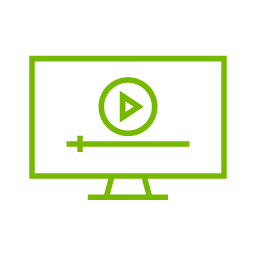NVIDIA Nsight Graphics
NVIDIA Nsight™ Graphics is a standalone developer tool with ray-tracing support that enables you to debug, profile, and export frames built with Direct3D, Vulkan, OpenGL, OpenVR, and the Oculus SDK.
Learn how Nsight Graphics can be used to accelerate development and help make high-performance games with beautiful graphics.
Optimize Performance
Graphics optimization and hardware utilization shouldn’t be ambiguous. Nsight Graphics offers an unparalleled level of access into the performance markers of your graphics API—an invaluable aid in finding optimization opportunities that couldn’t be identified without looking under the GPU’s hood.
Debug Graphics
Nsight Graphics enables smooth graphics development on NVIDIA platforms. Identify bugs and trace them back to their source on the target application, including real-time shader debugging. At its most granular, Nsight Graphics lets developers inspect every individual event involved in generating a frame—down to the pixel.
Boost Ray Tracing
The Ray Tracing Inspector in Nsight Graphics enables the next generation of real-time rendering technology. Analyze ray tracing efficiency, improve acceleration structures, optimize axis-aligned bounding boxes (AABBs), build flags, and overlaps. The entire frame can be thoroughly examined to ensure the best image fidelity and frame performance.
Explore Key Features
Track GPU Performance
Analyze GPU throughput and utilization with minimal overhead for non-biased activity data. On the captured timeline, drill down into critical performance markers and inspect hardware unit throughputs, cache hit rates, memory throughput, and more.
 GPU Trace showing a full timeline of application workload.
GPU Trace showing a full timeline of application workload. Trace analysis automatically identifying performance blockers.
Trace analysis automatically identifying performance blockers.Analyze GPU Traces
Nsight Graphics supports automated performance analysis on captured GPU traces. Deep profiling of streaming multiprocessor (SM) performance is accomplished by automatically tracing the execution of shaders across a series of frames.
Debug Ray-Tracing and Shaders
Debug ray-tracing API calls and examine their state. The Ray Tracing Inspector exposes acceleration structures, helping you optimize how rays intersect with the geometry in your scene. You can also examine ray tracing efficiency to ensure ray-traversal speeds are high.
Debug shader code with the Vulkan Shader Debugger, which exposes shader source in your render pipeline in real-time so you can quickly make fixes directly to the code.
 The Ray Tracing Inspector analyzes ray tracing efficiency and reveals acceleration structures.
The Ray Tracing Inspector analyzes ray tracing efficiency and reveals acceleration structures. Shader timing heatmap makes a stalling shader issue clear with a red hotspot.
Shader timing heatmap makes a stalling shader issue clear with a red hotspot.Profile Ray-Tracing Shaders
The Nsight Graphics Shader Profiler exposes shader data, including stalls and the reasons they occurred. The Real-Time Shader Profiler allows you to view the most expensive shaders at each moment in real-time. And the shader timing heatmap visualizes hotspots overlaid on the scene where shader times lagged per pixel.
Profiling ray-tracing shaders can be an arduous task that requires extensive knowledge of the GPU. These features turn ray-tracing profiling into a streamlined and intuitive process.
Export C++ Capture
Create a self-contained C++ project that allows for frame analysis in a reduced CPU-load scenario. This lets you perform repeatable and isolated analysis without being bound to the original application and provides a protected environment for experimenting with optimization tweaks.
 Images of Hellblade: Senua's Sacrifice courtesy of Ninja Theory Ltd; Hellblade is a Direct3D 12 / DXR game based on Unreal Engine 4.
Images of Hellblade: Senua's Sacrifice courtesy of Ninja Theory Ltd; Hellblade is a Direct3D 12 / DXR game based on Unreal Engine 4.View Other Tools Within the Nsight Suite
Nsight Graphics is part of the NVIDIA Nsight Developer Tools suite; a collection of powerful tools, libraries, and SDKs that enable developers to build, debug, and profile software utilizing the latest accelerated computing hardware.
Nsight Aftermath SDK
Nsight Aftermath SDK is a library that integrates into a D3D12 or Vulkan game’s crash reporter to generate GPU “mini-dumps” when an exception or TDR occurs, exposing pipeline information to resolve an unexpected crash.
Nsight Systems
NVIDIA Nsight Systems is a system-wide performance analysis tool designed to visualize an application’s algorithms, help you identify the largest opportunities to optimize, and tune to scale efficiently across any quantity or size of CPUs and GPUs.
Nsight Perf SDK
NVIDIA Nsight Pef SDK is a graphics profiling toolbox that enables you to collect GPU performance metrics directly from your application. Leverage the built-in HUD renderer for real-time, high-level performance triage.
Check out partner testimonials and ecosystem







Watch Nsight Graphics Tutorial Series
Fundamental concepts in graphics development, and key tips for ensuring peak performed, are explored with Nsight Graphics.
How to Improve Shader Performance by Resolving LDC Divergence
Avoiding Stalls and Hitches in DirectX 12
Building Acceleration Structures Using Async Compute
Watch Nsight Graphics sessions and technical videos on demand
Stay up to date on the latest Nsight Graphics news
Find more resources
Ready to get started with NVIDIA Nsight Graphics?

